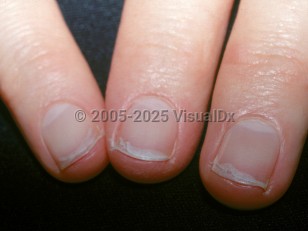Onychoschizia - Nail and Distal Digit
Alerts and Notices
Important News & Links
Synopsis

Onychoschizia has been observed in around 9% of pregnant individuals and represents the second most common nail finding in pregnancy along with onychocryptosis (9%) and leukonychia (24.4%).
Brittle nails have also been associated with systemic diseases, including endocrinopathies, tuberculosis, Sjögren syndrome, and malnutrition. Onychoschizia is a common finding in Sézary syndrome and, along with anonychia and distal notching, may differentiate from the nail findings in early mycosis fungoides. (The most common nail findings seen in early mycosis fungoides are longitudinal ridging, nail thickening, nail fragility, and leukonychia.)
The horizontal splits are most commonly seen in the distal portion of the nail and nail edge; proximal onychoschizia has been observed in patients with psoriasis or lichen planus and in those on oral retinoid therapy.
Toenail onychoschizia has been observed in around one-third of newborns younger than 5 days, and fingernail and toenail involvement is seen in 2.4% of children aged 0-2 years. In the fingernails, thumb sucking is thought to be contributory. It is thought that this splitting is secondary to the thin nails in newborns and children that are easily separated with minor trauma. It resolves as the child gets older.
Codes
L60.3 – Nail dystrophy
SNOMEDCT:
82144009 – Lamellar nail splitting
Look For
Subscription Required
Diagnostic Pearls
Subscription Required
Differential Diagnosis & Pitfalls

Subscription Required
Best Tests
Subscription Required
Management Pearls
Subscription Required
Therapy
Subscription Required
Drug Reaction Data
Subscription Required
References
Subscription Required
Last Updated:08/09/2021
 Patient Information for Onychoschizia - Nail and Distal Digit
Patient Information for Onychoschizia - Nail and Distal Digit- Improve treatment compliance
- Reduce after-hours questions
- Increase patient engagement and satisfaction
- Written in clear, easy-to-understand language. No confusing jargon.
- Available in English and Spanish
- Print out or email directly to your patient


